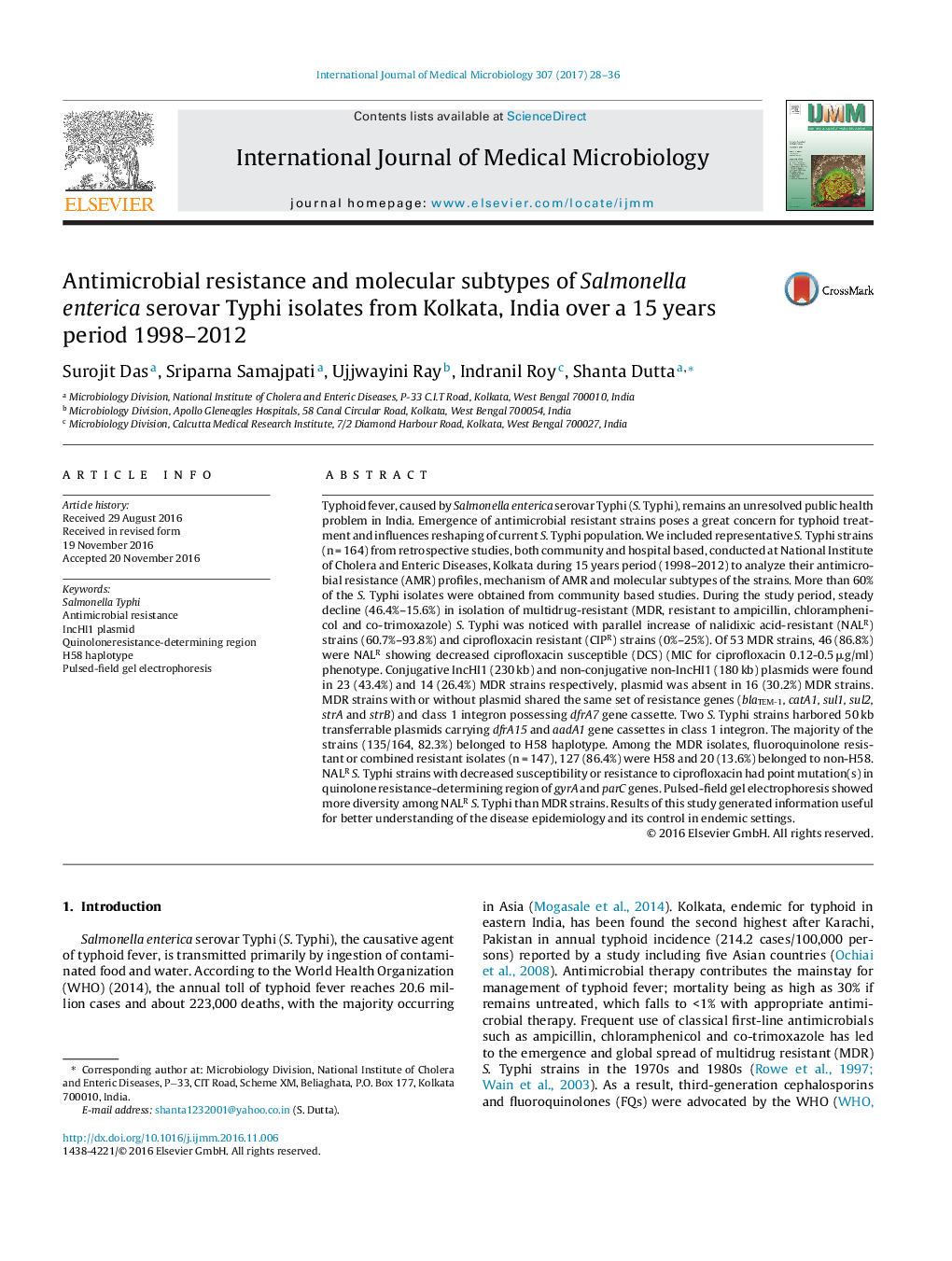| کد مقاله | کد نشریه | سال انتشار | مقاله انگلیسی | نسخه تمام متن |
|---|---|---|---|---|
| 5517797 | 1543674 | 2017 | 9 صفحه PDF | دانلود رایگان |

- Multidrug-resistant S. Typhi declined with increase in nalidixic acid and ciprofloxacin resistance during 1998-2012.
- H58 haplotype was detected in majority of strains associated with either multidrug and/or fluoroquinolone resistance.
- Multidrug-resistant strains with or without plasmid shared the same set of resistance genes.
- Fluoroquinolone resistance was mediated by quinolone resistance-determining region mutation(s) in gyrA and parC genes.
- Pulsed-field gel electrophoresis showed more diversity among nalidixic acid-resistant strains than multidrug-resistant strains.
Typhoid fever, caused by Salmonella enterica serovar Typhi (S. Typhi), remains an unresolved public health problem in India. Emergence of antimicrobial resistant strains poses a great concern for typhoid treatment and influences reshaping of current S. Typhi population. We included representative S. Typhi strains (n = 164) from retrospective studies, both community and hospital based, conducted at National Institute of Cholera and Enteric Diseases, Kolkata during 15 years period (1998-2012) to analyze their antimicrobial resistance (AMR) profiles, mechanism of AMR and molecular subtypes of the strains. More than 60% of the S. Typhi isolates were obtained from community based studies. During the study period, steady decline (46.4%-15.6%) in isolation of multidrug-resistant (MDR, resistant to ampicillin, chloramphenicol and co-trimoxazole) S. Typhi was noticed with parallel increase of nalidixic acid-resistant (NALR) strains (60.7%-93.8%) and ciprofloxacin resistant (CIPR) strains (0%-25%). Of 53 MDR strains, 46 (86.8%) were NALR showing decreased ciprofloxacin susceptible (DCS) (MIC for ciprofloxacin 0.12-0.5 μg/ml) phenotype. Conjugative IncHI1 (230 kb) and non-conjugative non-IncHI1 (180 kb) plasmids were found in 23 (43.4%) and 14 (26.4%) MDR strains respectively, plasmid was absent in 16 (30.2%) MDR strains. MDR strains with or without plasmid shared the same set of resistance genes (blaTEM-1, catA1, sul1, sul2, strA and strB) and class 1 integron possessing dfrA7 gene cassette. Two S. Typhi strains harbored 50 kb transferrable plasmids carrying dfrA15 and aadA1 gene cassettes in class 1 integron. The majority of the strains (135/164, 82.3%) belonged to H58 haplotype. Among the MDR isolates, fluoroquinolone resistant or combined resistant isolates (n = 147), 127 (86.4%) were H58 and 20 (13.6%) belonged to non-H58. NALRS. Typhi strains with decreased susceptibility or resistance to ciprofloxacin had point mutation(s) in quinolone resistance-determining region of gyrA and parC genes. Pulsed-field gel electrophoresis showed more diversity among NALRS. Typhi than MDR strains. Results of this study generated information useful for better understanding of the disease epidemiology and its control in endemic settings.
Journal: International Journal of Medical Microbiology - Volume 307, Issue 1, January 2017, Pages 28-36